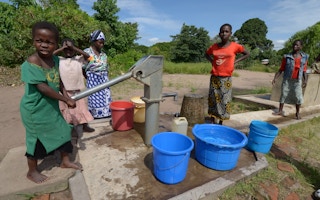2014 and 2015 were the hottest years on record and moving into 2016 we are in the midst of a super El Niño which has fuelled some of the worst wildfires on record in Indonesia. Worldwide, East and Southern Africa have been hit hardest – as an example, Ethiopia is experiencing the worst drought in over 50 years and the number of food insecure people jumped from 2 million at the beginning of 2015 to 10.2 million in December 2015.
The UN Office for the Coordination of Humanitarian Assistance (OCHA) speaks of grave challenges faced by the humanitarian sector as record numbers of people are displaced for longer periods by natural disasters and escalating conflicts which often add to existing vulnerabilities caused by poverty, food insecurity and exclusion.
Conflicts, natural disasters and other pressures such as population growth and rapid urbanisation are expected to continually increase humanitarian needs. The increasing scale and complexity of these needs call for new and more effective ways of delivering aid and preparing for emergencies. Three key trends are about to change the way humanitarian aid is delivered – all with compelling business opportunities:
- The resilience revolution: Resilience has become one of the top buzzwords in the development sector, bridging the climate change, sustainable development and humanitarian assistance agendas. With crises inevitable, the economic and social costs of disruptive events can only be reduced through greater investments in resilience building.
Simply put, resilience refers to the ability to respond to, absorb, or recover from external stresses or shocks such as natural disasters, rising sea levels, or variable rainfall and temperatures. It addresses the underlying factors that make a community or system vulnerable to external stresses. It requires understanding and addressing risks before external shocks or stresses throw a community into crises.
Beyond programme partnerships with humanitarian actors seeking to build community resilience – through, for example, insurance products, livelihood interventions, or infrastructure – the private sector plays a crucial role in building resilience through risk-sensitive investments and driving government action on areas such as risk assessments, land-use planning, and building codes.
As an example, a collaboration between the Australian Red Cross and a group of major finance, insurance and telecommunications corporations has influenced the Australian government to invest in strengthening disaster resilience in communities. Ultimately, , a resilient economy and resilient community also make for a better business environment. - Power shifts: Traditionally it has been the international humanitarian system – comprised of the UN, donor countries, large international NGOs and the Red Cross/Red Crescent movement - that stepped in to help alleviate suffering in the aftermath of large scale emergencies. With the aim to increasing humanitarian effectiveness, consensus is building within the humanitarian system on the need to build and complement national and local capacities instead of bringing in outside capacities.
A review of humanitarian response practices commissioned by the UK government found that international response is all too often sweeping aside local responders and adding to the chaos, rather than alleviating it. Oxfam emphasises the importance of placing the responsibility in the hands of those closer to the emergency, i.e. governments in countries affected by crises, assisted and held accountable by local civil societies. Nationally or locally led response is faster and often more appropriate, as local actors most likely understand the context on the ground better than even the best-prepared international organizations.
International NGOs such as Oxfam have started working through local markets to provide relief items as a way to not only support the provision of crucial goods (e.g. water, hygiene kits) but also to support local market recovery and thus livelihoods. As part of cash transfer programmes, affected families receive cash to purchase needed goods in selected local shops, making physical aid deliveries obsolete.
Community traders, retail companies, banks, and ICT companies play a crucial role when international NGOs build the capacity of local governments and civil society for such programmes instead of delivering aid directly. - The innovation quest: The understanding that the humanitarian system needs to change in order to more effectively prepare for and respond to increasingly complex emergencies has led to a great interest in innovation. There has been a push to drive not only technological innovation but also to explore new humanitarian business models that imply new roles for traditional humanitarian actors.
According to OCHA there is a need to fundamentally alter the way business is done in the humanitarian system as the trajectory of humanitarian assistance is unsustainable (in the past 10 years the number of affected people has doubled, while the costs of aid has more than tripled) and humanitarian tools and services ill-suited to modern emergencies. Donor organisations are providing new funding models that are driving the development of pilot programmes and products.
Through helping drive innovation, businesses can amplify the effectiveness of humanitarian organisations and benefit from business opportunities. There is a great need for product and process innovation and a greater need for helping humanitarian organisations scale up and scale out successful ideas and build the leadership needed to drive change.
A reactive, piece-meal approach to dealing with emergencies rather than tackling risks and vulnerabilities is neither effective nor sustainable. As the humanitarian sector is transforming, the private sector, too, needs to rethink its engagements. It holds the products, tools, services and innovation capacity to help drive humanitarian effectiveness.
We saw an evolution in private sector engagement after the Indian Ocean Tsunami when businesses moved from philanthropic contributions to more strategic programme partnerships. Will 2016 hold the next evolutionary step where businesses are not only engaged but invested in tackling the humanitarian challenge?
Helen Roeth is an associate, CSR Asia. This post is republished from the CSR Asia weekly blog.











